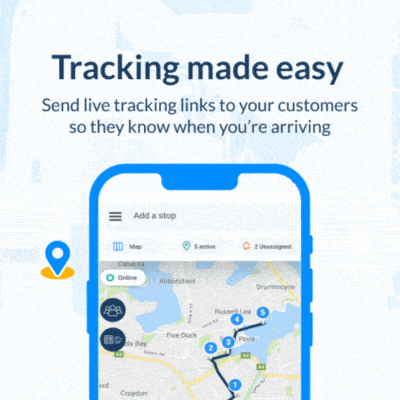Think about the administrative burden if a fleet manager has to manually keep tabs on the entire fleet, driver habits, maintenance, and fuel efficiency. Fleet management has its fair challenges, and without the right software, it can lead to errors and a waste of resources as well as money.
“Fleet management technology now can be a bridge to hiring and vehicle replacement later by making fleets more efficient and profitable,” says Peter Mitchell, senior vice president and general manager at Verizon Connect.
Increasing costs remain the top challenge (79%) among businesses, followed by a driver shortage and meeting customer demand.
A report called Fleet Management Trends states in its findings that fleet management technology can be an “effective cost-control tool—helping fleet managers get more out of existing resources, find new ways to cut costs, and become more competitive.”
Let’s explore some of the common challenges facing fleet managers in logistics and how to overcome them.
1. Fuel costs during delivery
Fuel is expensive! According to logistics experts, fuel will make up more than 50% of daily operational costs.
Budgeting your fuel expenses is also tough, as fluctuating fuel costs can make it difficult to predict how much it will cost at any given time.
Here’s how to solve it: Fleet management software reduces fuel costs by optimizing routes, tracking fuel consumption, and minimizing idle time. This can save up to 25% on fuel expenses.
When drivers are monitored in real-time, fleet managers can start reducing inefficient driving practices like hard braking and excessive idling, contributing to higher fuel consumption.

2. Regulatory compliance in transportation
Regular compliance with labor regulations, on-road regulations, roadworthiness checks, and industry standards can become tricky and overwhelming, especially when you try to keep track of a more extensive fleet with manual record-keeping.
Imagine drivers have lost their Hours of Service (HOS) records, or the business has fallen behind on several traffic fines.
If routine inspections are not done to comply with roadworthiness checks of vehicles, driver license checks, insurance upkeep, and vehicle legislation, your company will have to fork out thousands of dollars.
If your head is spinning already, fleet management software can help automate compliance tracking, maintain accurate digital logs of drivers, detect car license disk expiration, address traffic penalties, and perform other administrative tasks.

3. Driver safety and well-being
Monitoring driver safety when they are out on the road, and the fleet manager is sitting in the office is impossible. The only way to know exactly what’s going on in the fleet vehicles is with real-time tracking.
A driver might habitually speed, which increases their risk of being in an accident. If they do, it could have a ripple effect on fleet operations and insurance premiums. You’d also not know if the driver is tired and should not be behind the steering wheel in the first place.
According to the Australian Automobile Association, fatigue contributes to about 20-30% of all car crashes in Australia.
In the US, the picture also looks bleak. The National Highway Traffic Safety Administration reports that an estimated 100,000 crashes yearly are caused primarily by drowsy driving, resulting in an average of $12.5 million in damages.
With fleet management systems, managers can monitor driving patterns. The software sends alerts for unsafe behavior, giving managers enough time to intervene and call the driver to pull over for his/her safety.
With insight into the specific driver, the business can provide targeted training to individuals and focus on a specific problem.
4. Fleet vehicle maintenance
It’s inevitable, you’ll need to do regular maintenance on your vehicles, whether you have budgeted for it or not.
If you fall behind with vehicle maintenance, the consequences could be massive financial implications. Maintenance costs are expensive, and falling behind can be a big blow to the budget.
Ignoring fleet maintenance, or falling behind unexpectedly, can lead to unplanned breakdowns disrupting schedules and increasing repair costs. You won’t be able to control costs.
Fleet managers might not know about a vehicle’s brake issues until it causes an accident. Relying on drivers to inform managers about any concerns with their vehicles is not efficient.
Here’s how you can get around it. With fleet management software, preventive maintenance is scheduled. It will send notifications and alerts to managers.
How does it work? It’s based on mileage and usage data.

5. Driver behavior
Drivers can push the boundaries when they know no one is watching. Accelerating too fast, harsh cornering, driving while distracted. These all increase fuel usage and the risk of accidents.
A driver that frequently idles or brakes hard, raises expenses, making the job of fleet managers to control budget constraints, even harder.
The impact of bad driver behavior can mean a 25% variance in vehicle costs, says Chevin Fleet Solutions.
Fleet management solutions track behaviors like harsh braking and idling. This helps managers to coach drivers toward more efficient practices. Think of incentive programs to encourage better driving habits and rating drivers to gain access to performance bonuses.
6. Finding the best routes: Route optimization
Unpredictable factors lead to managers not finding the best routes. Traffic congestion, road closures, last-minute changes of delivery windows. All these factors contribute to the challenges experienced in fleet management.
Manual route planning often lacks real-time data, making it difficult to optimize fuel efficiency, reduce travel time, and meet customer expectations.
However, with fleet management software using GPS and live traffic data, the most efficient routes can be calculated with route optimization.
It automatically reroutes drivers, minimizing delays, idle time in traffic and estimates arrival times. It boosts fuel efficiency and saves time and money.

7. Driver shortages
Driver shortage is still a “top challenge” in the industry. However, according to a report on Fleet Technology Trends, using GPS tracking solutions “improves productivity.” The report suggests that the more productive employees are, the fewer drivers need to be hired to complete the workload.
For fleet management it’s difficult to recruit skilled drivers in the competitive market. This is also a significant problem during peak seasons when more seasonal staff is required.
In some instances, shipments can be delayed due to a lack of available drivers.
However, with fleet management software, drivers’ schedules are optimized with GPS tracking solutions, route optimization, real time communication, and driver feedback.
With fleet management software, managers can also make sure the load is spread evenly among drivers making them more productive. When drivers are happy, and their well-being is taken care of, driver retention is also improved.
8. Communications with drivers
Managing drivers can be time consuming. But frequent catch-up sessions are important, as it fosters trust and improves collaboration.
Communication is important for job assignments, route changes and any vital messages that the driver needs to know of.
If you have a large fleet, calling each driver when there is a change in plan, or a customer has asked for a change in delivery instructions, can be time consuming. It’s a challenge many fleet managers find frustrating.
These messages are automated when you use fleet management software. This leaves more time and space for more important information that needs to be communicated in person.
NOW READ: 7 reasons why you need better communication during delivery of parcels
Share this article
About the author
Mia is a multi-award-winning journalist. She has more than 14 years of experience in mainstream media. She's covered many historic moments that happened in Africa and internationally. She has a strong focus on human interest stories, to bring her readers and viewers closer to the topics at hand.













